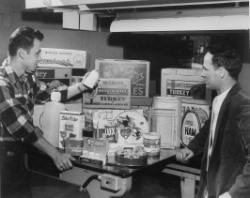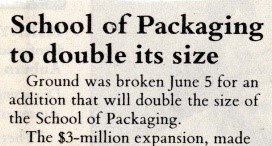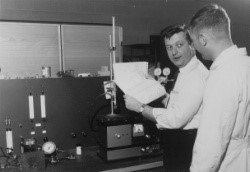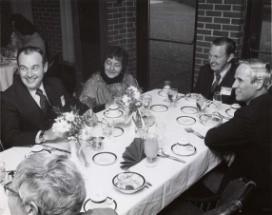History
Packaging Beginnings
In the fall of 1952, Packaging was created at Michigan State University as an academic discipline in the Department of Forest Products. The Packaging program was science and mathematics based with strong components in business, sociology and psychology. The first Bachelor of Science degree in Packaging was awarded in March 1955.
Since its beginning in 1952, the School has conferred over 10,000 degrees. Today, we have approximately 600 undergraduate and graduate students.
The School of Packaging has been involved in international activities since its beginning. International students seek admission into our graduate program from all over the world. More than half of our graduate students are international. After finishing their education, most international students return to their native countries and become leaders in their packaging industries. Our faculty travel extensively serving as consultants and participating in programs throughout the world. We have alumni chapters in many countries outside the United States.
J im Goff (right) with a student
im Goff (right) with a student
The School of Packaging continues to be a dynamic, ever-changing organization that responds to the needs of people.
In 1957, the MSU Board of Trustees separated the Packaging curriculum from Forest Products and established an independent School of Packaging. Industry assistance and advice were instrumental in the development of the School and remain so today.
By the late 1960s, enrollment had risen to about 300. Enrollment peaked at 1,000 students in 1981 and has since been restricted. In 1964, the original Packaging Building was completed with funds from corporate and private donors. Major additions to the building were completed in 1986, also through corporate and private donations. This resulted in a major improvement in the facilities and helped to accommodate a higher level of research.
From the mid-1960s to the late 1970s, the School began to develop significant research expertise and earned national and international recognition in physical distribution and protective packaging. The School continues to enjoy a worldwide reputation for leadership in this area with computer applications in cushion design, fragility assessment, distribution dynamics and modeling of the physical environment. Building on efforts related to water vapor permeability in the 1960s and expansion of the faculty in the 1980s, the School became known as a leader in the areas of permeability and migration, shelf life, food packaging, product/package compatibility, tamper evidence and legibility. These programs all continue today. In 1980, the School initiated an overseas study program in London, which was followed a few years later by a program in Lund, Sweden. In 1994 a program on packaging in Japan was added. Students from packaging programs across the United States participate in these courses. In the early 1980s, the School began to develop its outreach program. Efforts in this area have grown substantially and are an important part of our total program. The MSU School of Packaging is the leader among universities in lifelong education in packaging.
Timeline
School of Packaging Accomplishments 2000-2011
- New faculty and staff in the 2000s: Melvin Harder, Ron Iwaszkiewicz, Jane Crowner, Dr. Laura Bix, Dr. Maria Rubino, April Meersdom, Dr. Eva Almenar, Dr. Laurent Matuana, Dr. Pascal Kamdem, Cimberly Weir, and Sherrie Lenneman.
- Dr. Joseph Hotchkiss was appointed Director in October 2009.
- Fall 2001: Long Distance Learning MS Program began.
- June 2002: Happy 50th Anniversary! WorldPak MSU/IAPRI conference in East Lansing.
New research projects in the 2000s included:
-
- Radio frequency identification performance;
- Application of legibility tests to decisions about label design;
- Warning label design and its impact on the consumer's ability to notice;
- Test method development for hazardous materials and pharmaceutical packages in high altitude shipments
- Extrusion of biodegradable plastics
- Use of 1-MCP for extending shelf life of packaged produce;
- Study of characterization of PLA for food packaging;
- Development and characterization of gluten-based films;
- GC-MS and electronic nose analysis of off-flavors in packages;
- Electronic nose detection of pathogenic bacteria in packaged food.
Books written by faculty in the 2000s:
Plastics Packaging : Properties, Processing, Applications, and Regulations, by Ruben J. Hernandez, Susan E.M. Selke and John D. Culter. Munich, Germany and Cincinnati, Ohio: Hanser Gardener Publishers, 2000.
School of Packaging Accomplishments 1990-99
- The Ph.D. program in Packaging was first offered in 1996.
- The Overseas Study program in Japan was first offered in1994, and the program in Spain was first offered in 1999.
- Exchange programs with the University of Dublin, University College Cork (both in Ireland), the University of Reims, France, and The University of MAUA in Brazil were developed. The Visiting International Scholar Program was formalized.
- Dr. Bruce Harte was appointed Director in 1993.
- Analytical laboratories were upgraded, plastics processing capabilities were expanded and a computer-aided sample table was acquired.
- New faculty and staff in the 1990s: Dr. Alicia Gardiol, Dr. Parvin Hoojat, Charles Pierce, Ruth Kilbourne, Liliana Mina, Connie DeMars, Linda Belman, Renee Gagnier, Dr. Robb Clarke and (visiting faculty) Dr. John Culter.
Fall 1998: "1st Place" web based placement tool was first used.
New research projects in the 1990s included:
-
- Reusable shipping container economics and performance;
- Label legibility test method development and measurement;
- Measurement of truck, rail, air and ship transportation environments;
- Effects of shock, vibration and compression on packages and products;
- Evaluation of packaging based on environmental concerns;
- Development of software to assist in package design;
- Evaluation of seal integrity for medical devices;
- Cost relationships between bottle and blister packages for over-the-counter drugs;
- Predicting drug package shelf life using dissolution methods;
- Plastics recycling database;
- Polyolefin/natural fiber composite performance;
- The use of hydrocyclones for recycled plastic separation;
- Sulfonation of plastics to improve barrier properties;
- Effect of packaging and moisture content on solubility of drugs;
- Effect of UV light exposure on woven PP fabric;
- Migration of contaminates from recycled plastics through a functional barrier;
- Effectiveness of VCI packaging in corrosion inhibition;
- Evaluation of the effect of supermarket purchase decisions on packaging waste;
- Simulating the shelf life of moisture sensitive products and permeability database;
- Modified Atmosphere Packaging of pre-cut apple and the use of natural flavor compounds;
- Development of an immobilized oxygen biosensor;
- The properties of clay-polymer nanocomposites, wheat protein films and edible films from milk whey;
- Barrier characteristics of metallocene films;
- Packaging materials for high-pressure processing foods;
- Finite element modeling to estimate shelf life;
- Stability and effectiveness of UV absorbers;
- Effect of microwave heating on PP crystallization and mechanical properties;
- Partition coefficients between aroma compounds and plastics;
- Off flavor in milk due to packaging volatiles migration;
- Influence of microwave heating on formation of N-Nitrosames in bacon.
Books written by faculty in the 1990s:
-
- Biodegradation and Packaging: a Literature Review, by Susan E.M. Selke. Leatherhead, Surrey: Pira, 1990. Second edition published in 1996.
- Packaging and the Environment : Alternatives, Trends, and Solutions, by Susan E.M. Selke. Lancaster : Technomic, 1990. Second edition published in 1994.
- Barcodes and Other Automatic Identification Systems, by Robert D. LaMoreaux. Leatherhead, Surrey: Pira International, 1995.
- Packaging of Pharmaceuticals and Healthcare Products, by Hugh Lockhart and Frank A. Paine with invited contributions from M. I. Robertson, R. R. Evans and J. Garbett. London: Blackie Academic & Professional, 1996.
- Understanding Plastics Packaging Technology, by Susan E.M. Selke. Munich, Germany and Cincinnati, OH: Hanser/Gardner Publications, 1997.
- Distribution Packaging for Logistical Systems: A Literature Review, by Diana Twede and Ben Parsons. Leatherhead, Surrey: Pira, 1997
- Packaging Materials, second edition, by Diana Twede and Ron Goddard. Leatherhead, Surrey: Pira, 1998.
- Plastics Packaging : Methods for Studying Mass Transfer Interactions: A Literature Review, BY Ruben J. Hernandez and Rafael Gavara. Leatherhead, Surrey, UK : Pira International, 1999.
School of Packaging Accomplishments 1980-89
 The number of students briefly ballooned to over 1000 (with over 50 graduate students) and the staff was dramatically expanded. New faculty and staff in the 1980s included Dr. Theron "Tee” Downes, Don Abbott, Paul Peoples, Dr. Rick Brandenburg, Dr. Gary Burgess, Dr. Robert LaMoreaux, Margaret Michel, Alan Adams, Sterling Anthony, John Dargis, Dr. Mike Richmond, John Sneden, Norm Asmun, Karen Case, Betty Karmann, Dr. Paul Bankit, Sue DeRosa, Dr. Susan Selke, Susan Anderson, Barbara Hasbrook, Bob Hurwitz, Dr. Christopher Lai, Dr. Ruben Hernandez, Roger Griffin, Joe Irvin, Dennis Young, Tammy Cady, Peggy Nuerenberg, Glen Pettit, Robin Rotz, Dr. S. Paul Singh, Mary Anne Merrill, Beverly Underwood, Colleen Wager. Visiting faculty included Joe Miltz, Sun Kai and Kit Yam.
The number of students briefly ballooned to over 1000 (with over 50 graduate students) and the staff was dramatically expanded. New faculty and staff in the 1980s included Dr. Theron "Tee” Downes, Don Abbott, Paul Peoples, Dr. Rick Brandenburg, Dr. Gary Burgess, Dr. Robert LaMoreaux, Margaret Michel, Alan Adams, Sterling Anthony, John Dargis, Dr. Mike Richmond, John Sneden, Norm Asmun, Karen Case, Betty Karmann, Dr. Paul Bankit, Sue DeRosa, Dr. Susan Selke, Susan Anderson, Barbara Hasbrook, Bob Hurwitz, Dr. Christopher Lai, Dr. Ruben Hernandez, Roger Griffin, Joe Irvin, Dennis Young, Tammy Cady, Peggy Nuerenberg, Glen Pettit, Robin Rotz, Dr. S. Paul Singh, Mary Anne Merrill, Beverly Underwood, Colleen Wager. Visiting faculty included Joe Miltz, Sun Kai and Kit Yam.
- Two significant retirements: Dr. Goff in 1987 and Elizabeth "Mrs. A.” Anderson in 1989.
- The Japanese MSU Packaging Chapter was established in 1980.
- The first Packaging overseas study program was offered in the United Kingdom in 1981, and the first program in Sweden was offered in 1986.
- In 1981 the Industry Advisory Committee was re-established.
- MSU hosted the 4th International IAPRI Conference in 1985.
- Dr. Harold Hughes was appointed as Director in 1986.
- The new addition to the Packaging building was completed in 1987. It was built as the result of a University-wide capital campaign.
- The Packaging curriculum was reorganized in 1987 to increase the packaging material content and enhance the technical emphasis. The Management and Technical options were merged.
- In 1987 MSU listed the School of Packaging among its "all-time10 greatest accomplishments” in response to a request from the National Association of State Universities and Land Grant Colleges to indicate the valuable contributions member institutions have made to bettering the lives of people throughout the world:
- "The School of Packaging is illustrative of the Land Grant University responding to a specific demonstrated need of society.”
- Under the direction of Joe Irvin, Lifelong Education program offerings were expanded.
- In 1988 the Center for Food and Pharmaceutical Packaging Research was established. In 1990 the Consortium of Distribution Packaging was formed.
- The School was computerized in the late 1980s as computers were acquired and increasingly used by faculty, staff and students.
New research projects in the 1980s included:
-
- Measurement of dynamics in rail cars and trucks;
- Tamper evidence effectiveness;
- Aroma barriers, flavor sorption scalping and mechanical properties of plastics;
- Recycling of HDPE milk bottles, HDPE/wood fiber composite performance;
- Child resistant packaging innovation and evaluation;
- Release of flavor compounds and flavor uptake in plastic materials;
- Modeling the sorption of water vapor by amorphous polyamides;
- Permeability and diffusion of organic vapors and oxygen in plastic films;
- Effect of sorbed compounds on adhesion of multilayer structures;
- Label legibility investigations;
- Effect of thermal mechanical history on diffusion and sorption in PET;
- Heat sealant parameters of EVA sealant copolymers;
- The influence of packaging on food product shelf life;
- Transfer of antioxidants to packaged food products and effect on shelf life;
- Volatiles migration to microwavable packaged food;
- Effect of transient vibration on the compressive strength of corrugated boxes;
- Influence of oxygen absorbers on product stability;
- Effect of fluorescent light on food product quality.
Books written by faculty in the 1980s:
- Shake and Break: Laboratory Adventures in Packaging Dynamics, by James Goff and Diana Twede published by the authors in 1982.
- Fundamentals of Packaging Dynamics, by Richard K. Brandenburg and Julian June-Ling Lee. Minneapolis, Minn. : MTS Systems Corporation, 1985.
- Packaging Perspectives, by Donald L. Abbott. Dubuque,, IA: Kendall/Hunt,1989.
School of Packaging Accomplishments 1970-79
- In the mid-70s, there was a precipitous drop in enrollment because students were drawn to programs perceived to be more environmentally favorable, because of a general distrust of business and government, and because of a lack of jobs due to the recession.
- New faculty and staff in the 1970s included Wayne Clifford, Ed and Wilesse Comissiong, Sergei Guins, Susan Halter, Dr. Istvan Gyeszly, Douglas Novakoski, Gunilla Jönson, John Hendee, Roxanne Chatman, Terry Baird, Dr. Kalman Peleg, Mary Corp, Diana Twede, Dr. Jack Giacin, Dr. Bruce Harte and Dr. Julian Lee.
- Dr. Lockhart came back.
- In 1976 a cooperative agreement with the USDA gave MSU the technical support responsibility for food aid packaging, including test method development, supervision of test shipments to Manila, Africa, India and Haiti. Many students participated. This relationship continued for 25 years.
- Research projects in the 1970s included:
- Shock and vibration research expanded as new technology was acquired;
- Loss and damage studies conducted for the US Postal Service;
- Economic effects of bottle bill legislation.
- Dr. Chester Mackson was appointed as Director in 1977.
- The number of students briefly ballooned to over 1,000 (with over 50 graduate students) and the staff was dramatically expanded.
- New faculty and staff in the 1980s included Dr. Theron "Tee” Downes, Don Abbott, Paul Peoples, Dr. Rick Brandenburg, Dr. Gary Burgess, Dr. Robert LaMoreaux, Margaret Michel, Alan Adams, Sterling Anthony, John Dargis, Dr. Mike Richmond, John Sneden, Norm Asmun, Karen Case, Betty Karmann, Dr. Paul Bankit, Sue DeRosa, Dr. Susan Selke, Susan Anderson, Barbara Hasbrook, Bob Hurwitz, Dr. Christopher Lai, Dr. Ruben Hernandez, Roger Griffin, Joe Irvin, Dennis Young, Tammy Cady, Peggy Nuerenberg, Glen Pettit, Robin Rotz, Dr. S. Paul Singh, Mary Anne Merrill, Beverly Underwood, Colleen Wager. Visiting faculty included Joe Miltz, Sun Kai and Kit Yam.
School of Packaging Accomplishments 1960-69
- The multisponsor research program was proposed in 1960. The first supporters were General Motors and Proctor and Gamble and the research began on cushioning materials, water vapor transmission rate, heat sealing methods, machinability of packaging materials, gas permeability and package economics. From the beginning, almost all of the School's research activity was industry supported. Total receipts from the program exceeded two million dollars, which was used for facilities, equipment and research staff.
- The Glass Container Manufacturers' Institute laboratory moved to MSU to be near the program and employ students.
- Mrs. Elizabeth Anderson ("Mrs. A”) was appointed as Secretary in 1961. Other faculty and staff hired in the 1960s included: Steven Pierce, Dr. David Olsson, Howard Blake III, David Brouse and Dr. John Turk.
- In 1962 the Packaging Management curriculum was added to the technical curriculum.
- The first female student, Eileen Emerick, enrolled in 1963. After the first 3 female students graduated, an extensive effort was undertaken to increase the number of female and minority packaging majors.
- The curriculum was revised in 1963 to form two 6-credit courses (PKG 320 and PKG 422) and a new shock and vibration course–PKG 423–was created for the technical option (a counterpart of PKG 428, Packaging Design, for the management option). By this time, there was also a course in line machinery and statistical quality control (PKG 425) and three graduate courses.
- From 1964 until the early 1980s, a compressed version of the core courses was offered every summer. At least a thousand people took these courses over the years, although most did not earn degrees.
- In 1964 the "old part” of the current facility was built from funds raised by the Packaging Foundation and from overhead earned from the multisponsor research program.
- In 1966 Dr. James Goff was appointed Director of the School of Packaging, and for the first time the School had its own separate budget.
- In 1966 the MSU Packaging Society (also known as the "Packaging Club”) became the first student chapter of the Society of Packaging and Handling Engineers. It later became the first student chapter of IoPP.
- In 1968 the Packaging Alumni Association was formed as a special interest group under the bylaws of the MSU Alumni Association. Its first newsletter in Summer 1968 notes 800 alumni

- Research projects in the 1960s included:
-
-
-
-
-
-
-
- Loss, damage, and test method development for the furniture industry;
- Permeability of packaging materials and shelf life estimation;
- Development of quasi-isostatic test methods for permeability measurement;
- The heatsealability of plastics using infrared energy.
-
-
-
-
-
-
-
Packaging: A Scientific Marketing Tool, by Harold J. "Pete” Raphael, published by the author and MSU Book Store, 1969.
School of Packaging Accomplishments 1952-59
- The idea for a packaging major was first conceived by Dr. Alexis J. Panshin, Chair of the Michigan State College Forest Products program, and John Ladd (General Box Co) in 1950. They believed that a university-level packaging course would be of great value in attracting young people to careers in packaging and providing packaging firms with fresh new talent that might otherwise be diverted into different fields. The proposed "wooden box” program was expected to increase the number of students in the Forest Products Department.
- September 1, 1952: The Packaging Program began under the leadership of Dr. Panshin, in the Department of Forest Products, reporting to Dr. Paul Herbert, a veteran of both World Wars who had seen first-hand the waste of millions of dollars of ammunition and supplies due to faulty packaging.
- A graduate student named Jim Goff was appointed as an Instructor to develop the program. He was expected to teach three courses: Wood & Fiber Containers, Container Packing and Container Handling & Loading.
- The Packaging Institute, led by Dr. Larry Burton, conducted a survey and issued Advisory Service Report Number 323 in April 1953, outlining the need and recommending content for a four-year packaging curriculum that was significantly broader than the "wood box” model proposed.
- The School's first Industrial Advisory Committee met in 1953 and approved a new curriculum that included 7 packaging-specific courses--Principles of Packaging, Wood & Paper Technology, Packaging Materials, Industrial Packaging, Consumer Packaging, Packaging Cost Analysis, Packaging Problems–and 12 weeks of practical experience in industry.
- In 1953, MSC hosted two Military-Industry packaging conferences. It brought in many prominent packaging people and was a great public relations boost for the program. Other demand-side PR efforts included an exhibit at the National Packaging Exposition at Chicago's Navy Pier and articles in Modern Packaging magazine championed by Bruce Holmgren.
- The first student, David Seagrave, enrolled in Spring 1953. His friends and articles in the State News and Lansing State Journal were good PR for recruiting students. By Fall 1953, there were seventeen students and the first course was taught.
- In Fall 1954 the program moved into its first separate building, the "Bee House” and the Packaging Society was formed. In 1955 Dr. Harold J. "Pete” Raphael transferred ("was shanghaied”) from Wood Technology to the Packaging program.
- The first fund raising drive commenced in 1955-56 to buy urgently needed lab equipment, ranging from sample table and tensile tester to weatherometer.
- In 1957 the Industry Advisory Committee morphed into the Board of Trustees of the Packaging Foundation, which was created to raise funds ($2 million goal) to build laboratories.
- Dave Seagrave graduated in 1955 with the first BS degree. Alfred A. Barker (from the UK) enrolled in 1953 as the first MS candidate and international student
 The packaging major officially became The School of Packaging in 1957 with Dr. Panshin as Director. There were now 139 students enrolled.
The packaging major officially became The School of Packaging in 1957 with Dr. Panshin as Director. There were now 139 students enrolled.- In 1958 Pi Kappa Gamma (PKG) was formed, and in 1959 the School moved to A2 temporary building with the help of the two student organizations: PKG and the Packaging Society.
- Dr. Hugh Lockhart, then a graduate student, was first appointed Assistant Instructor in 1959
- (l to r) Paul Peoples, Geno Goff, Bruce Holmgren, Jim Goff



 Print
Print Email
Email